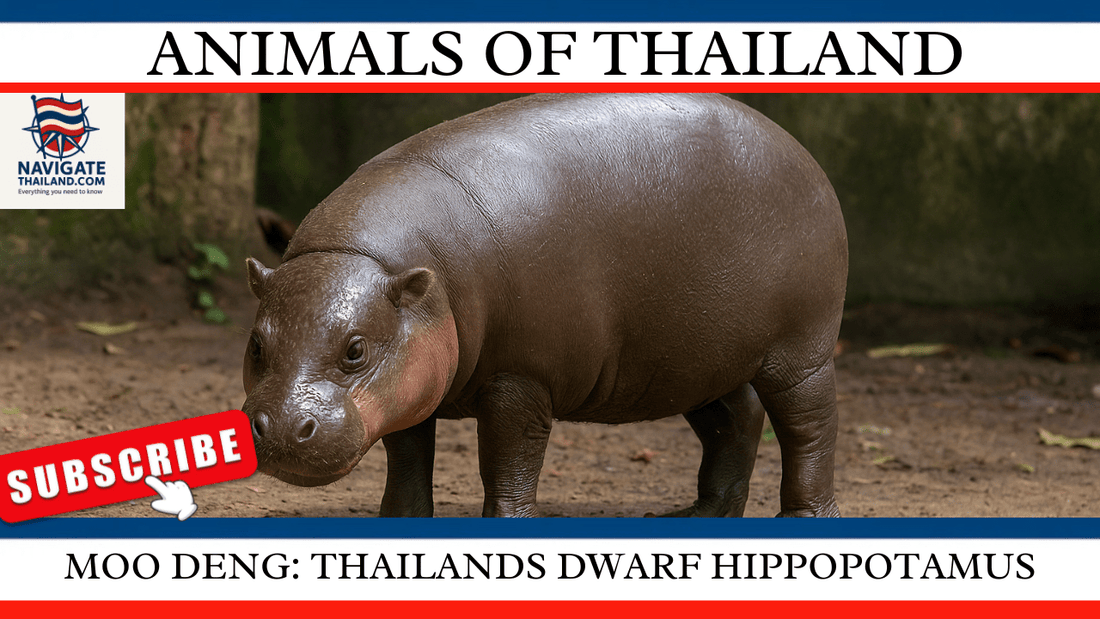
Moo Deng: Thailand’s Dwarf Hippopotamus
Share
When you think of hippos, the image that probably comes to mind is of a large, bulky animal lounging in the rivers of Africa. However, tucked away in Thailand’s remote rainforests is a rare and remarkable animal that few people know about: Moo Deng, Thailand’s so-called “dwarf hippopotamus.” This enigmatic and little-known creature has sparked the imagination of wildlife enthusiasts and researchers alike.
In this article, we’ll dive deep into the world of Moo Deng, uncovering everything there is to know about this unique animal. From its habitat and behaviour to the challenges it faces in the wild, Moo Deng is a symbol of Thailand’s diverse and precious wildlife.
What is Moo Deng?
Contrary to what the name suggests, Moo Deng is not a true hippo. The term “Moo Deng” translates to “red pig” in Thai, which gives us a clue about this animal’s appearance. Locally, this nickname has been given to a smaller species of pig or wild boar that roams Thailand’s dense forests. However, because of its slightly stockier build, semi-aquatic lifestyle, and occasional reddish-brown skin, some have playfully likened it to a miniature version of a hippopotamus.
Although not a relative of the large African hippos, this species’ lifestyle is what gave rise to the nickname. Found mostly in swampy, wet areas of Thailand’s jungles, Moo Deng is one of the lesser-known animals, blending into the shadows of Thailand’s rich biodiversity.
In popular culture and folklore, Moo Deng has long been an intriguing animal, especially due to its secretive nature and isolated habitat.
A Closer Look: Habitat and Lifestyle of Moo Deng
The dwarf hippopotamus, or Moo Deng, primarily inhabits the dense and remote rainforests of Thailand’s southern provinces, where it has adapted to a semi-aquatic lifestyle, similar to its namesake, the African hippo. Moo Deng thrives in wetlands, swampy areas, and riverine forests, where it forages for food and remains hidden from predators.
Although the exact population of Moo Deng is unknown, this animal is believed to be highly elusive. It is mostly nocturnal, spending the day hiding in dense vegetation or mud to avoid the heat. Like true hippopotamuses, Moo Deng relies on water for thermoregulation and spends much of its time in the water to stay cool in Thailand’s humid climate.
Fun Fact: While Moo Deng spends a lot of time near water, it is also a fantastic digger! It’s been observed that this creature can dig small burrows to seek refuge during dry periods.
What Does Moo Deng Eat?
Moo Deng is primarily a herbivore, feeding on grasses, fruits, aquatic plants, and even crops in certain regions. It is also known to scavenge for food near water sources and is particularly fond of fallen fruits and tender grasses found in the wet undergrowth.
One of Moo Deng’s unique feeding habits is its ability to forage both on land and in water. When feeding in shallow waters, it uses its keen sense of smell and well-developed snout to locate edible plants. Similar to true hippos, Moo Deng plays a crucial role in maintaining the delicate balance of its ecosystem by controlling the vegetation in its habitat.
How Did Moo Deng Get Its Name?
The name “Moo Deng” has a rich cultural background in Thailand. In Thai, “moo” means pig, and “deng” means red, which directly translates to “red pig.” This name likely arose from the animal’s reddish-brown colouration, especially when it is seen wallowing in the mud or under the tropical sun. Locals have long referred to this animal with a mixture of reverence and curiosity due to its resemblance to both pigs and hippos.
Despite the playful nickname, Moo Deng has come to represent an important part of Thailand’s natural heritage, and its survival is crucial to maintaining biodiversity in the country’s rainforests.
Challenges Faced by Moo Deng in the Wild
Like many other species in Thailand, Moo Deng faces several challenges that threaten its survival in the wild. Some of the most significant threats include:
1. Habitat Loss: The ongoing deforestation and conversion of forest land for agriculture and development have greatly reduced Moo Deng’s habitat. As wetlands and forests are cleared, Moo Deng is forced into smaller, fragmented patches of forest, which disrupts its natural behaviour and access to food.
2. Human-Wildlife Conflict: In regions where Moo Deng lives near farmland, there have been instances of conflict with humans. As Moo Deng often feeds on crops, local farmers may perceive them as pests and try to drive them away, sometimes leading to harmful encounters.
3. Poaching: Although not widely hunted for sport, Moo Deng is sometimes targeted by poachers for its meat or because of the perceived threat it poses to crops. Hunting and trapping have contributed to the decline in Moo Deng populations in certain areas.
4. Climate Change: The changing climate has also impacted Moo Deng’s wetland habitat. Extended dry seasons and irregular rainfall patterns can affect the availability of water, forcing Moo Deng to venture further from its usual territory in search of food and water.
Conservation Efforts: In recent years, conservation organisations and the Thai government have recognised the need to protect the unique ecosystems that support species like Moo Deng. Local wildlife sanctuaries and national parks play a critical role in safeguarding the habitats of rare species. However, more research is needed to fully understand the population dynamics and long-term survival prospects of this elusive animal.
Cultural Significance of Moo Deng
Moo Deng holds a special place in Thai folklore and culture. Many rural communities view this animal as a symbol of resilience due to its ability to survive in challenging environments. Stories about Moo Deng have been passed down through generations, and its name is often invoked in relation to local tales of luck, survival, and adaptation.
In some areas, Moo Deng is believed to bring good fortune, particularly if one encounters it in the wild. However, its elusive nature and shrinking habitat have made sightings increasingly rare.
Are There Dwarf Hippopotamuses in Thailand?
While Moo Deng is referred to as Thailand’s dwarf hippopotamus, it is important to note that true dwarf hippopotamuses (Choeropsis liberiensis) are native to West Africa, particularly in countries like Liberia and Sierra Leone. These dwarf hippos are closely related to the common hippopotamus (Hippopotamus amphibius) but are significantly smaller and live primarily in forested areas.
Moo Deng, on the other hand, is more closely related to pigs and wild boars, despite its name. Nevertheless, the moniker “dwarf hippopotamus” has stuck, possibly due to the animal’s robust, semi-aquatic nature and similar physical features.
What Does the Future Hold for Moo Deng?
The future of Moo Deng in Thailand is uncertain. While conservation efforts have helped protect certain species in Thailand’s rich ecosystems, more needs to be done to ensure the survival of Moo Deng. Public awareness and education about the importance of preserving wildlife habitats are crucial in protecting this rare species.
With continued research and conservation efforts, there is hope that Moo Deng will thrive in Thailand’s rainforests for generations to come. Local communities, researchers, and government officials must work together to find solutions to human-wildlife conflict and promote sustainable land-use practices that support both biodiversity and human livelihoods.
Fun Fact: Some researchers believe that the Moo Deng’s elusive nature has helped it avoid the same fate as other larger, more conspicuous animals. Its preference for dense, remote habitats has kept it safe from widespread hunting and poaching, making it one of the more mysterious creatures in Thailand’s forests.
Conclusion
Moo Deng, Thailand’s so-called dwarf hippopotamus, may not be a true hippo, but it is certainly a fascinating and unique creature that represents the incredible biodiversity of Thailand’s rainforests. Despite the challenges it faces, Moo Deng continues to survive in the wild, a testament to its resilience and adaptability. By learning more about this rare species and supporting conservation efforts, we can help ensure that Thailand’s rich natural heritage is preserved for future generations.
References
1. Thai Wildlife Conservation Society – “Species of Thailand’s Rainforests”
2. Department of National Parks, Wildlife and Plant Conservation, Thailand
3. The Encyclopedia of Thai Flora and Fauna – “Mammals of Thailand”
4. WWF Thailand – Conservation Efforts in Southeast Asia
5. National Geographic – “The Mystery of Thailand’s Moo Deng: A Rare Encounter”
Read more of our Thailand blog series:
Thai Food Guide:Traditional Recipes and Street Eats
Everything Travellers Need to know
Thailand travel ebooks and language guides
Thailand Travel Apparel & Souvenir Gifts
Subscribe to our YouTube channel Navigate Thailand to see our most popular Thailand travel blogs turned into videos:
Navigate Thailand YouTube channel










































































































































